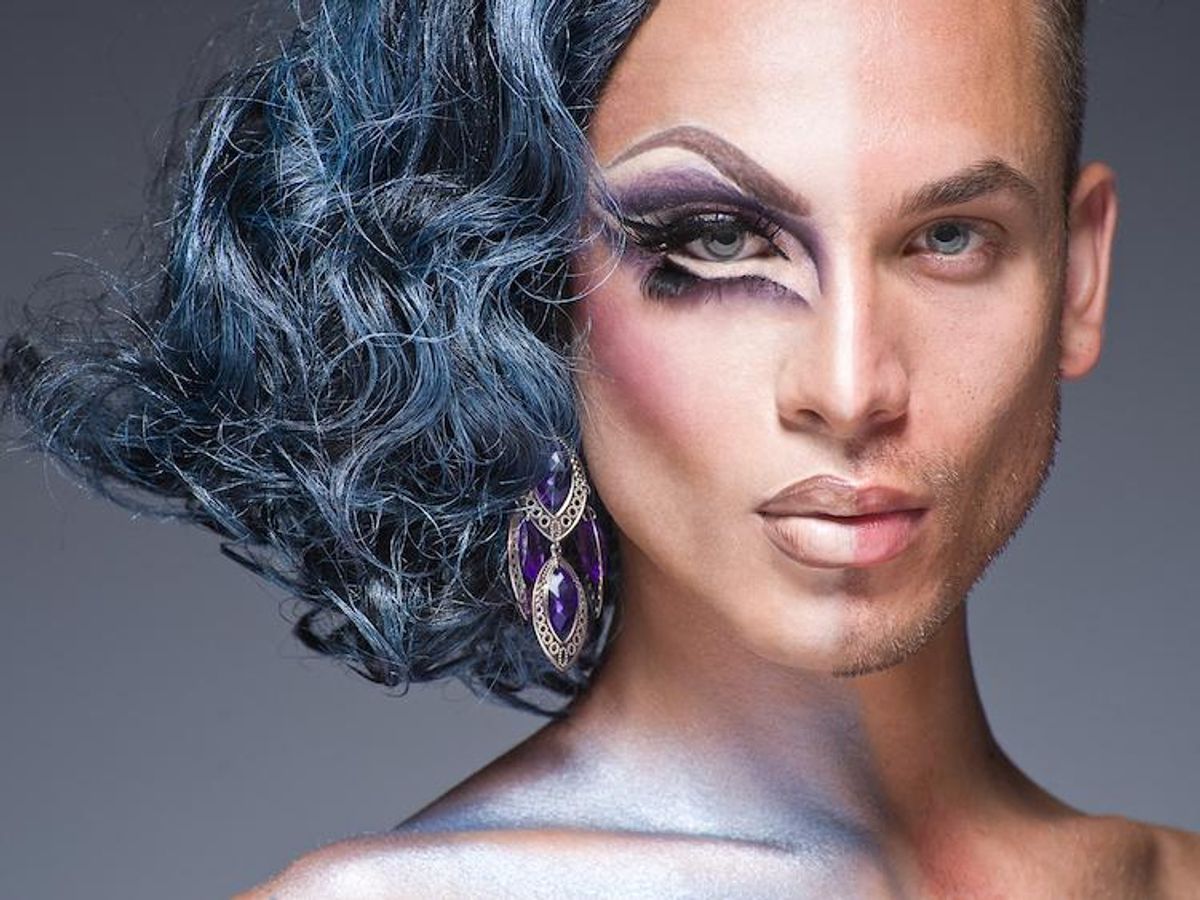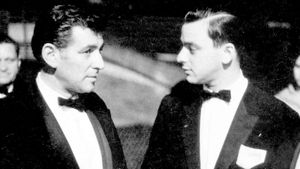Half-Drag photo (above) by Leland Bobbe
Miss Fame wants to be seen. I meet the unparalleled drag queen and Rupaul's Drag Race season 7 cast-off at a tiny New York cafe, but she wants to relocate. We pack up our stuff and walk around a bit before she says, "Let's go to Starbucks. I want people to see me." Fame, born Kurtis Dam-Mikkelsen, is out of drag, and though still very stunning as a street-clothed man, she's not quite the head-turner as when transformed into her full, "Rolls Royce of drag" persona. But, then, we are in Hell's Kitchen on a Friday night, and the recognition doesn't take long. A half-drunk woman stops us both on a street corner and tells Fame how much she digs Drag Race and that the show "gives her life." She compliments Fame, who accepts it with grace, but also beaming willfulness. "I love it," Fame says. "I enjoy communicating and getting to show who I am."
Fame is refreshingly transparent about her addictions to both attention and beauty--including, but not limited to, her own. A recovered addict who got sober at 20 shortly after coming out, Fame, who's now 30, has adopted beauty as her new drug of choice, getting high off the "top-shelf drag" she delivers. For that and other reasons, it all seems to go beyond vanity. "Who doesn't like to be validated and complimented?" Fame says. "It's very kind to give love in a very validating way. I think telling people they look good, no matter your size, your age, or whatever, is important. Give positive affirmation to another human being, especially within the gay community--and especially within the drag community."
Yet, is vanity such a bad thing? To look at Miss Fame is to look at a specimen of biological and cosmetological perfection, the impact of which should not be understated. On Drag Race, a show that requires its contestants to turn out a balanced mix of inventive drag, performance skills, humor, and even relatability, the girliest (or "fishiest") queens are almost always clocked for "resting on pretty," or at the very least warned against it. Fame hasn't rested on pretty, but the truth is, she could if she wanted to. In our society, there's a hypocrisy in that we live in a beauty-driven culture; however, the value of beauty and its visceral power are actively underplayed, as if appreciating surfaces is automatically equated with shallowness. Moreover, the very same people who appreciate beauty can also be threatened by it, resulting in them shunning something that, if they were being honest, affects them quite deeply. This concept becomes the crux of my conversation with Fame--the most aesthetically polished queen to ever appear on RuPaul's show--as opposed to the cliched notion that there's an actual person behind that beaten face. Because of course there is. "If I'm that striking, of course I will give you more depth," Fame says. "That's why I'm going to continue making art and content that's really beautiful. But, also, if you've got it, flaunt it."
It's Fame who offers to categorize beauty as something "profound." She's inundated herself with reference images of the great beauties who've inspired her, and she labels Linda Evangelista the "most profound" supermodel of all time. "She still has presence," Fame says. "She could still walk into any room and command it. Any one of those supermodels from the 1990s could command and stomp out any new model today, because of the weight of what they did back then, and because they have an ownership and knowledge of the industry that we've lost. Linda Evangelista is still iconic and her images still captivate. You could run any one of them in Vogue today."

We continue talking about the merits of the look of a supermodel. During her time on Drag Race, Fame was repeatedly called out for struggling with certain aspects of the show's performance challenges, and occasionally given jabs by the other queens for simply being "a supermodel." Like all of us, Fame has certain limits (it's bittersweetly appropriate she was sent home after an "ugly" challenge, since she simply can't do ugly), but why on earth would her being a drag supermodel be considered a bad thing, especially when her execution is of such admirable--and, yes, profound--flawlessness? Exhibiting the kinds of discrimination that still happen within the queer community itself, Fame's competitors faulted her for what may very well be her calling.
Another of Fame's icons and obsessions is Vanna White, a woman who's been paid millions to basically stand there and look pretty. And while people may joke that White's job is a preposterously easy ride, all of them, from truckers to housewives, probably love her anyway, a big reason being because she's...what? Sickeningly beautiful. Fame divulges her model dreams. She acknowledges that trans models such as Carmen Carrera and Andreja Pejic are being accepted into the fold, but what about a drag supermodel? (RuPaul's hottest single may remain 1993's self-affirming "Supermodel," but the icon never officially made the haute-couture leap.) Fame explains that she wants to do more editorials with photographers. It's part of what brought her from Sacramento to New York more than four years ago.
"Different photographers knew me because I used to model as a boy," Fame says. "I came here with the aspiration to feel beautiful in New York City. And then that chapter wasn't happening. I had an agent, I was doing some editorials, and I have beautiful photographs, but I wasn't getting paid big bucks to be a male model in New York. It's the most competitive place in the United States for models because the people that live here are the most beautiful people. I thought, Am I really pursuing the right dream? Makeup was intuitive and felt right, and I was able to make other people feel good about themselves."
Fame eventually became the makeup artist for Jersey Shore's Snooki and Jwoww, a gig that soon got her attention for other jobs at MTV and, in one way or another, paved a path toward Drag Race (MTV owns Drag Race's home network, Logo). Along the way, the modeling ambitions began to trickle back, but in a whole new fashion. "Miss Fame started happening at the same time I was doing makeup," she says. "I was working at MAC and they were like, 'Can you show up at a charity event in drag and do a performance for the MAC AIDS Fund?' So, I ended up getting in drag, going to the Ritz and doing my first performance in New York City."
Key among Fame's obsessions is the concept of "the image," and doing whatever possible to achieve it. Another of her aesthetic, iconic influences is Marlene Dietrich, the woman after whom Fame has modeled her drag silhouette, and whose photographs could stop a truck. Fame whips out her phone and pulls up a reference image, before sharing with me the bodily torment she endures to achieve the look of "the cosmic supermodel that is Miss Fame."

"Here's Marlene," Fame says. "Look at the body. Tiny waist, hips and tits up. Then think how you've seen my body in life. It is that. It's an unreal shape and it's painful. To look like that hurts and I'm obsessed with the pain of it. It's a sacrifice I'm willing to take, because the end goal is a standard of beauty that I don't feel we have enough of. You have to want it. That's why I really respect [fellow season 7 contestant] Violet Chachki and her corset training, because I relate to it. We look at each other in admiration, because we're willing to sacrifice on a physical level and put ourselves through physical pain for hours that's unreal, just to make an image that looks good."
When asked what level of pain she's in when in full regalia, on a scale of one to 10, Fame answers, "About nine or 10. It's fucked up. I'm miserable. People are like, 'Oh my god, do you have resting bitch face.' And when you're in that much pain, you can't let somebody have it, because you're hurting. Your feet go numb. You're tucked so fiercely that you end up having blisters in places you don't want them, and your skin's rubbing off, and your body's rigged. Even Violet -- when I'm helping her out of her corset--she's had really bad blisters on her ribcage from corsets. And I would have the same situations. I've worn things that have cut lines and scarred my physical boy body, like a corset that was made of steel, because I wanted to do it for an editorial and it looked so good. The whole time I'm like, 'Fuck, I'm destroying myself. I have a laceration.' "
She continues, "And then I'm wearing my facelift tapes, and wigging myself up and pulling my face up and wrapping my head in an ace bandage, to create this full on, highly-feminized face, without a line or a wrinkle, and everything's up like I've had surgery. It gives me a migraine and then your hair comes out from the wig where you put a pin, because it hits that pressure point in the center. You'll notice with a lot of drag queens, right in the center where a pin goes, their hair will fall out and they'll have to let it grow back. So anyway, when I came back from the show I was completely wrecked. My feet were numb. I got nerve damage because I brought Jimmy Choos. Those shoes are not meant to be standing-room shoes for a long time. They're like, a look shoe for a fashion shoot and then you take them off. I wish I could have brought my stripper heels, so that I could have enjoyed the night and not been sitting there, like, bleeding inside my body. It took months to recover from Drag Race."
And still...Fame is utterly obsessed. Does she suffer for her art more than other queens? It's impossible to say. Anyone who's seen Violet Chachki cinch her waist to within inches of her life knows it can't be pleasant, and who knows what RuPaul herself has endured to look like a million dollars on the runway? But, however it's achieved, Fame's meticulousness and impeccable editorial sensibilities make her one helluva standout, even if she becomes so immersed in them that they cloud her awareness. (The running joke of "How's your head?" this season picked on Fame for supposedly being far too much inside of her own.) They'll also likely prove that, while Drag Race gave Fame an incalculable boost in notoriety (as it does for any queen), it's a venue she can thrive without, and, perhaps, for which she's just not suited.
And there's nothing wrong with that. While Drag Race may be the holy grail for many queens aching to get their name out there, it is not, by any means, guaranteed to crown "America's next drag superstar." America's next well-rounded drag superstar? That's probably more accurate. Fame has more specific ambitions, and more specific skill sets--which, as queens who've begged her for makeup tips will tell you, are undeniable. She seems to have it in her to be America's first drag supermodel. And still, she's not limiting herself, either. She says she's a painter and a writer. The day after she was eliminated from Drag Race, she dropped the video for the knowingly titled "Rubber Doll," the first single off of her upcoming studio album. Is it the song of the summer? No. But it's catchy as hell, and in the video, Fame is intoxicating--flawlessly slaying as usual.
"Why wouldn't I explore all genres of art as Miss Fame to discover what really is my calling?" she muses. "I was excited about the music. I've been writing my life down on paper for nine years in journal entries. There's a lot of things people don't know about me. So, when I was asked to co-write my album and really put my thoughts and feelings down, and have somebody direct it and make it music, my storyline, I was excited about taking it to the next place. I'm in a very 'yes' place of life right now. Saying yes to opportunities and seeing what it looks like. Why not?"
Watch the "Rubber Doll" video below:
Follow R. Kurt Osenlund on Twitter.


























































































